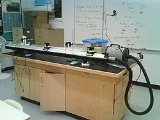
Air Track
Encyclopedia
- See also AirTrack (disambiguation) for other uses.

Motion (physics)
In physics, motion is a change in position of an object with respect to time. Change in action is the result of an unbalanced force. Motion is typically described in terms of velocity, acceleration, displacement and time . An object's velocity cannot change unless it is acted upon by a force, as...
in low friction
Friction
Friction is the force resisting the relative motion of solid surfaces, fluid layers, and/or material elements sliding against each other. There are several types of friction:...
environment. Its name comes from its structure: air is pumped through a hollow track with fine holes all along the track that allows specially fitted air track cars to glide relatively friction-free. Air tracks are usually triangular in cross-section. Carts which have a triangular base and fit neatly on to the top of the track are used to study motion in low friction environments.
The air track is also used to study collisions, both elastic and inelastic. Since there is very little energy lost through friction it is easy to demonstrate how momentum is conserved before and after a collision. The track can be used to calculate the force of gravity when placed at an angle.
It was invented in the mid-1960s by John Stull and Frank Ferguson.

